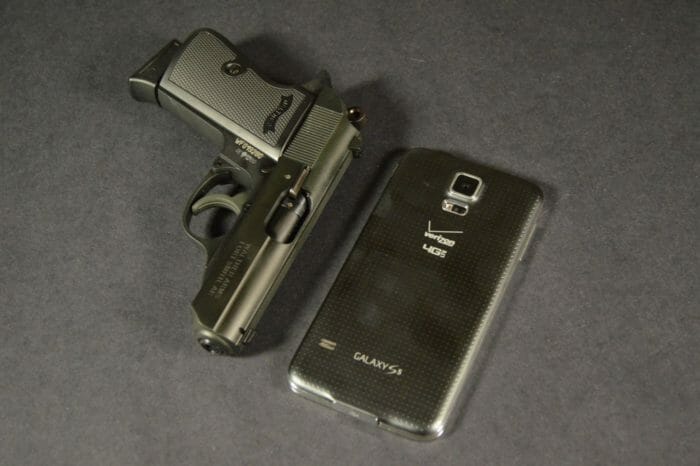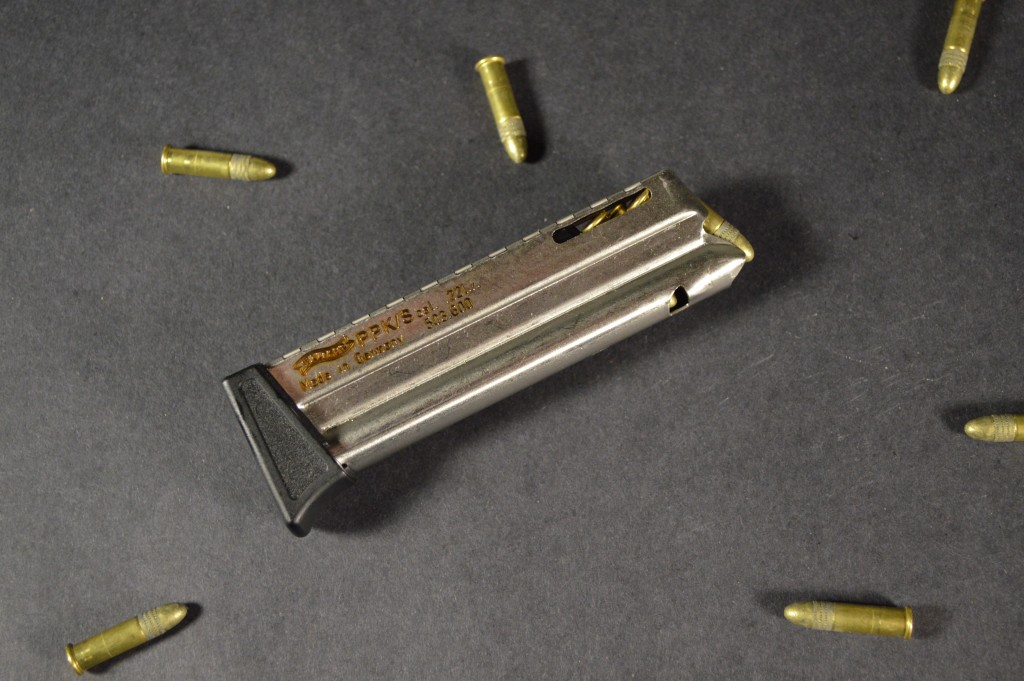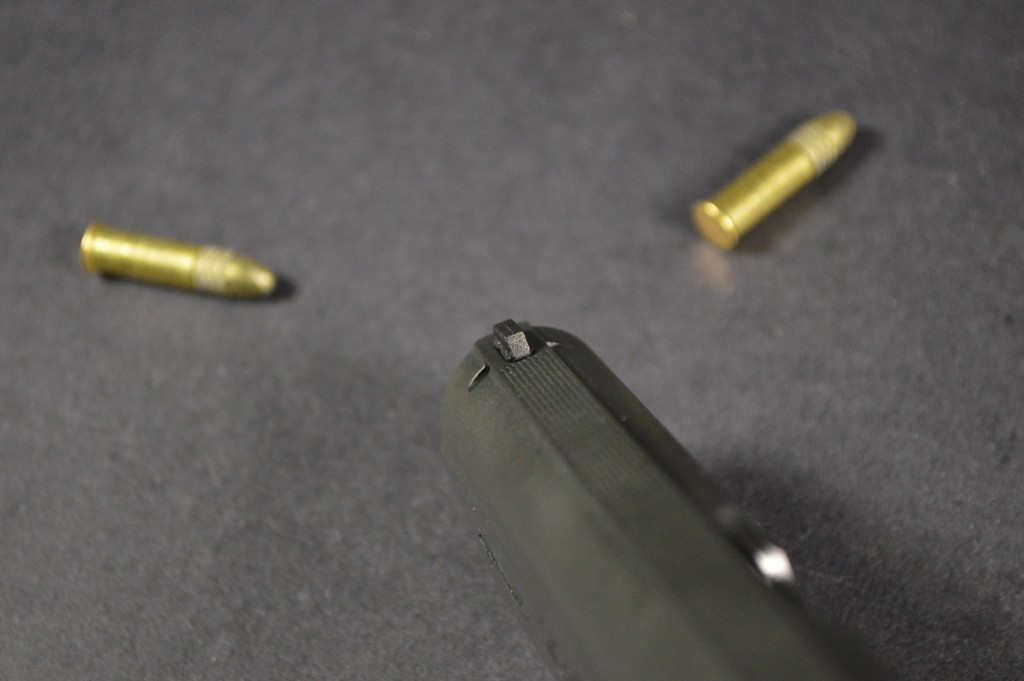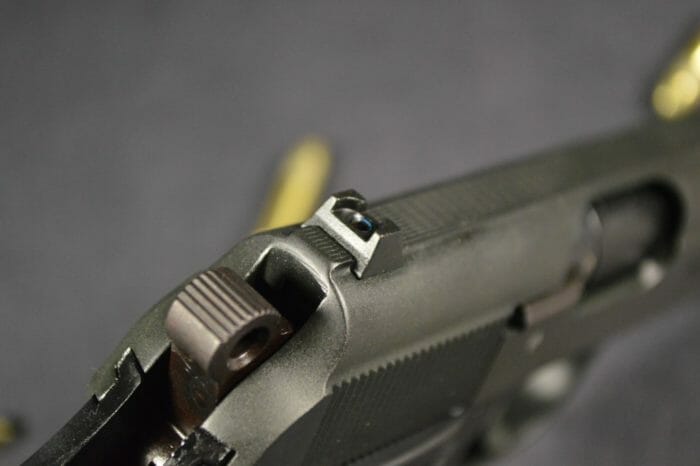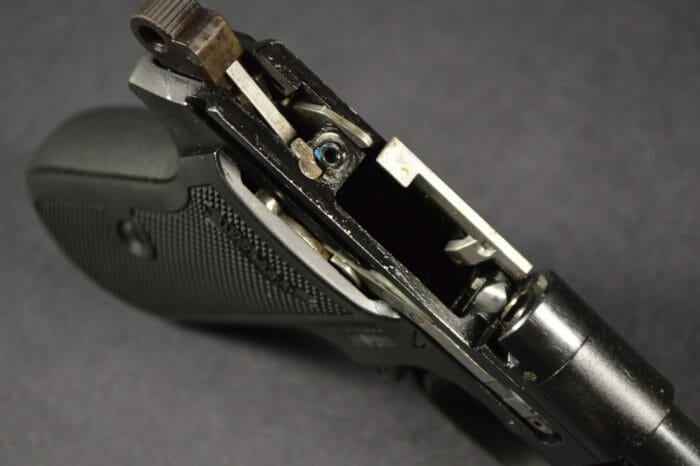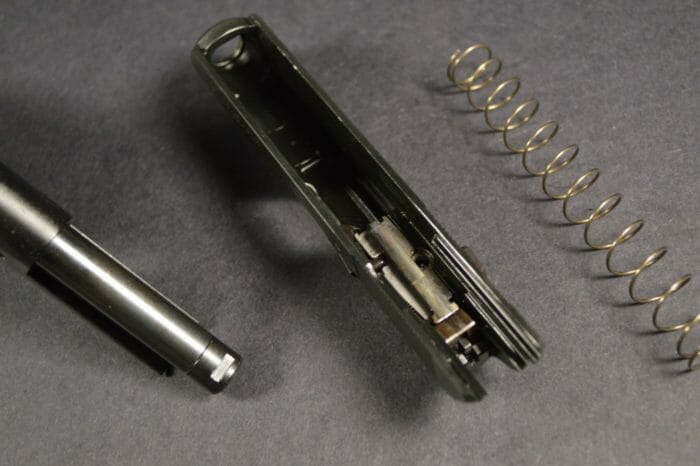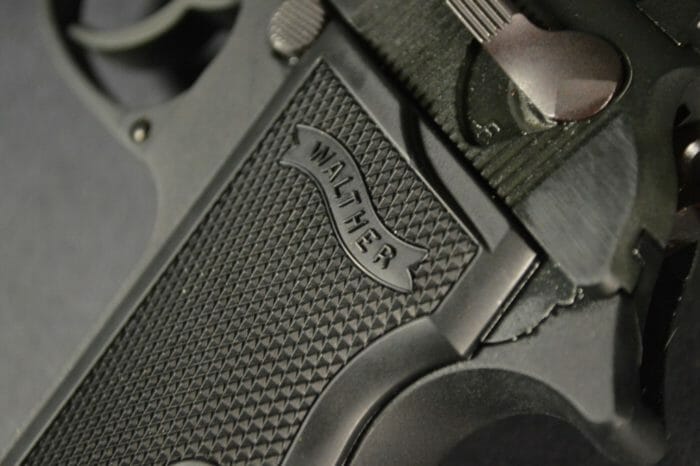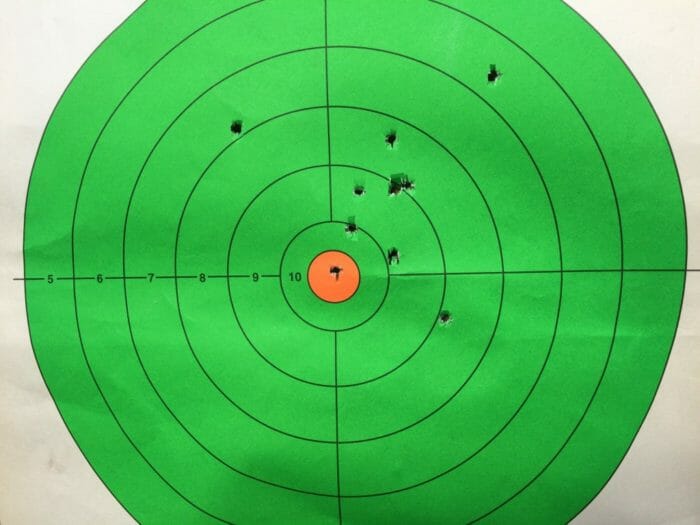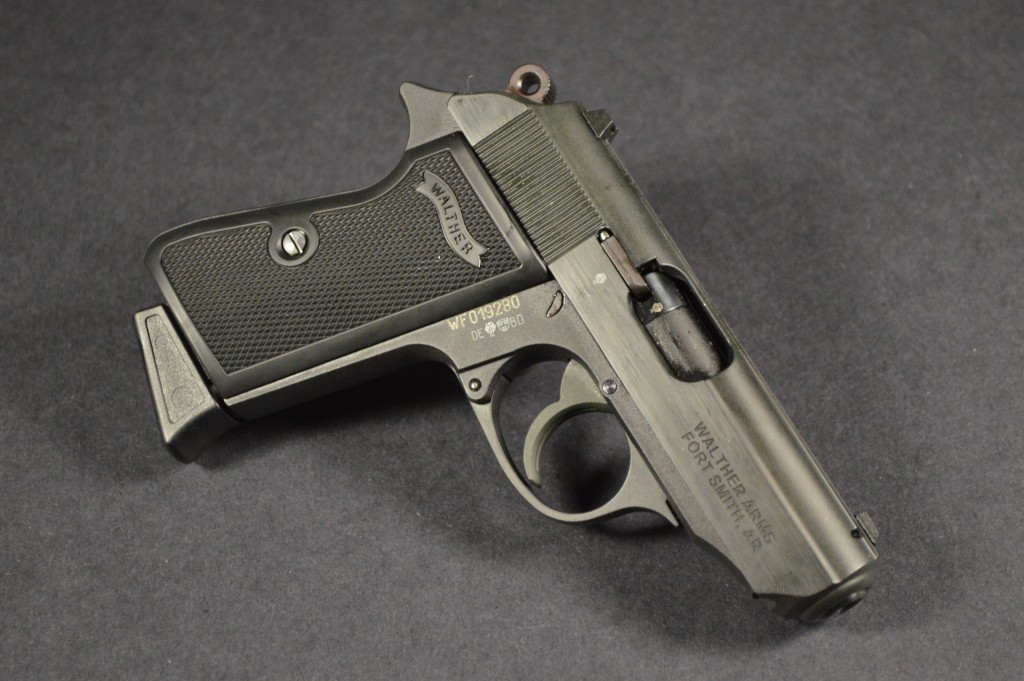Walther PPK/S .22 LR Review
When I purchased my Bersa Thunder 22 back in 2012, I primarily wanted a .22 LR trainer for full-sized, centerfire pistols. I had little experience shooting anything other than rifles and my handgun skills were essentially non-existent. As a secondary benefit, I also liked how the Bersa resembled the Walther PP and PPK series handguns made famous by the James Bond series of novels and films. Furthermore, I was fascinated by the PP family’s historical significance as popular sidearms for German officers in World War Two. Since original .22 LR PPKs typically fetched over $600 at the time (and still do), the Bersa was a nice alternative with similar size and looks.
Unfortunately, the love affair with the Bersa was short lived. It was too small to use as practice for full-sized handguns and its lack of barrel threads rendered it useless as a suppressor host. Shortly after purchase, I sold it to acquire a Colt/Walther .22 1911, but my desire to own a PPK in .22 was as strong as ever.
Ironically, just months after I parted with the Bersa, Walther revealed their new PPK/S in .22 LR at SHOT Show 2013. I was excited to see life breathed into the classic design, but I already owned the Gold Cup 1911 and it worked well as an appropriately-sized trainer. Even so, I could not help but think of the PPK/S. After a few years of learning with the 1911 and lusting after the PPK/S, I finally caved to the pressure and earlier this month picked up Walther’s 2013 edition of the PPK/S .22.
Size & Weight
If you read gun forums long enough, you might think that the PPK/S much larger than it really us. At just 6” from beavertail to muzzle, the PPK/S is actually quite a bit smaller than most would have you believe. In fact, it is only a fraction of an inch longer than my Samsung Galaxy S5.
In order to meet import requirements after the Gun Control Act of 1968, Walther had to lengthen the grip on its PPK. For ease of manufacture, the company merged the larger frame of its PP with the shorter slide of the PPK to create the PPK Sport, or PPK/S. Unfortunately, some of the PPK/S’s compact nature is jeopardized by its PP-length grip. From the top of the rear sight to the bottom of the magazine’s extended base plate, the handgun measures right around 5” tall. This is a good bit taller than the standard PPK, which comes in at 4.5” tall with an extended base plate, but the pistol is still far more compact than I expected.
If you want to conceal the PPK/S the extra half inch of grip might be the difference between printing and true concealment. However, I cannot recommend using the rimfire PPK/S for this application. At the range, the longer grip offers more pinky real estate and makes the PPK/S considerably more comfortable to shoot.
When it comes to weight, the PPK/S is a little heftier than similarly-sized modern arms. According to my postal scale, Walther’s .22 LR version of the pistol weighs in at 1 lb 7.2 oz with an empty magazine. This is far from heavy, but if you’re used to toting a Ruger LCP, S&W M&P Shield, or Glock 42/43, the PPK/S is going to feel a bit overweight. Ultimately, I doubt anyone is going to choose the PPK/S (especially the .22 LR version) for its light weight, but for an all metal handgun, it really is not all that bad.
Magazines
The PPK/S .22 uses essentially the same magazine style as the rest of Walther’s modern .22 LR handguns. The body of the part is stamped steel and the magazine has a capacity of 10 rounds. At the bottom of the magazine is a plastic, extended base plate that helps to provide additional space for a shooter’s pinky finger. Unlike other Walther-designed .22 handguns, the PPK/S magazine does not have an external plunger to depress the follower and assist in loading. I found this somewhat disappointing as I frequently used the plunger on my Colt/Walther Gold Cup for a faster, easier loading process.
One important detail to note is that the new production PPK/S does not share magazine compatibility with past rimfire versions of the pistol. If you own an old PP or PPK .22 and hoped the new model would bring extra magazines to market, I am sorry to report that the new magazines will not work. On a more positive note, the old magazines featured a noticeably less aggressive feed angle and were prone to jamming. Walther’s new design seems to be much more reliable than past takes on the PPK in .22 LR.
Sights
It would be a major understatement to call the PPK/S sights minimalist. Little more than a standard U-notch and post pair, they are devoid of any dots or other painted details that might assist in aiming. Since I am far from an excellent pistol shooter, I would prefer for the PPK/S to have 3-dot military sights, but the traditionalist in me says the sights are fine as is. The rear sight on these newer rimfire PPKs is metal while the front sight is polymer. To accommodate a wide variety of ammunition weights and velocities, the PPK/S ships with three different front sights of various heights.
On my particular example, the rear sight was actually fairly loose out of the box and I found that a firm press on the left side of the unit would shift the whole sight to the right and out of the slide’s machined dovetail. Since the rear sight is made to be drifted for adjustment, it features a small set screw that prevents lateral movement when tightened. After a few clockwise turns on this screw, I managed to properly set my PPK/S’s rear sight, alleviating any further concerns.
Design and Materials
At its heart, Walther’s new take on the PPK/S .22 is mostly identical to the original, centerfire PP and PPK series handguns. Like its predecessors, the rimfire version uses a straight blowback system with a fixed barrel and a recoil spring that uses the barrel for a guide rod. The PPK/S’s trigger mechanism is very similar to that of its centerfire forefathers, but the double action pull is quite a bit heavier.
Disassembly of the PPK/S .22 is procedurally identical to centerfire versions of the gun. To field strip the firearm, simply pull down on the hinged trigger guard while pulling the slide up and to the rear. This allows the slide assembly to travel back far enough on the frame to disengage the rails. Next, lift the slide off the end of the barrel to reveal the recoil spring. For standard maintenance, further disassembly is unnecessary.
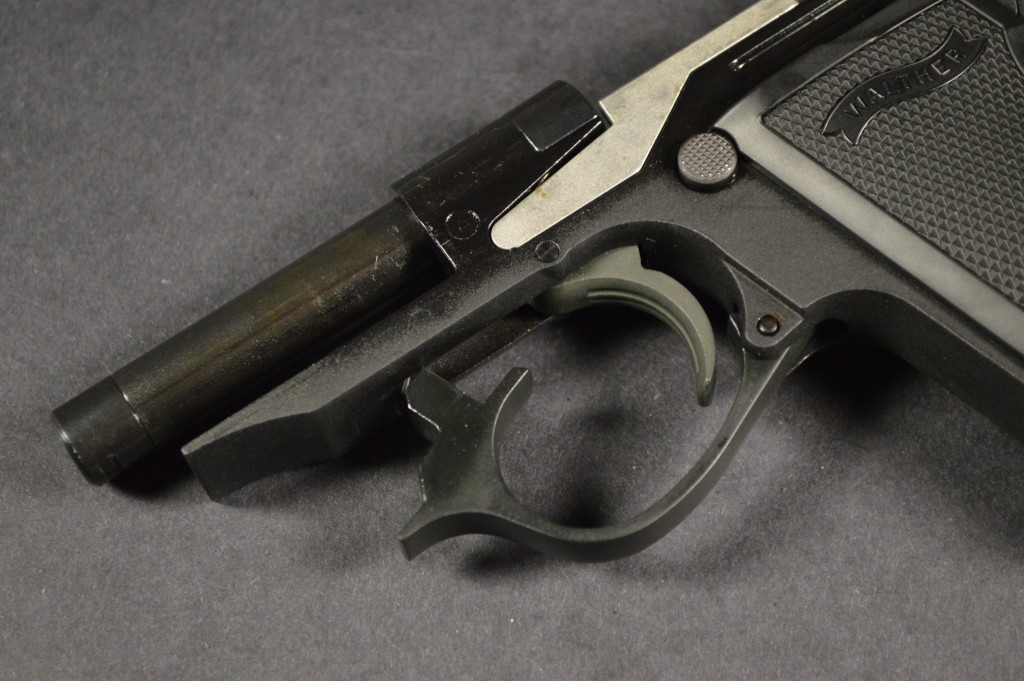
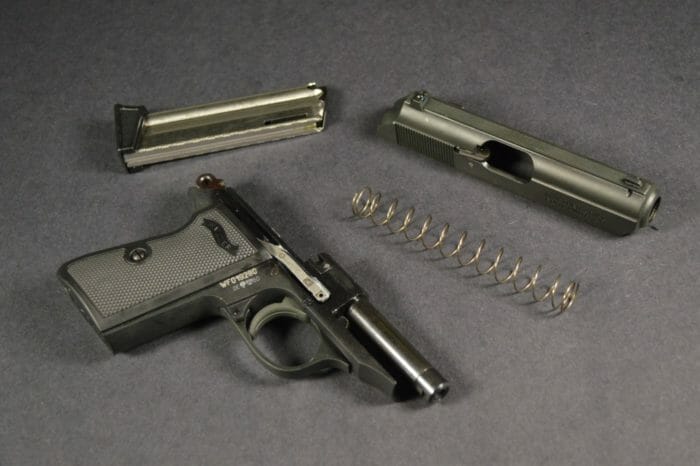
One of the drawbacks of the new PPK/S .22 is its barrel. Rather than opting for a traditional one piece unit, Walther used the same two piece design that is common in many of its .22 LR firearms. Not unlike an airsoft gun, the PPK/S features a thin inner barrel with rifling that functions much like any other. However, rather than provisioning additional thickness to the inner barrel in order to fit the pistol’s slide, Walther simply added an outer sleeve to the part. Suppressor users will be relieved to know that the barrel threads are cut into the inner barrel and are compatible with any P22-style thread adapters. The threads are certainly a welcome feature for suppressor owners and those who want the complete Bond look as classic .22 PPKs (and current Bersa pistols) did not offer any provisions for threads or adapters. Overall, the two piece barrel works fine and all reports seem to indicate that the thin inner barrel is perfectly acceptable from a durability standpoint. Still, the approach is a little cheesy and leaves the pistol feeling more like a toy than it should.
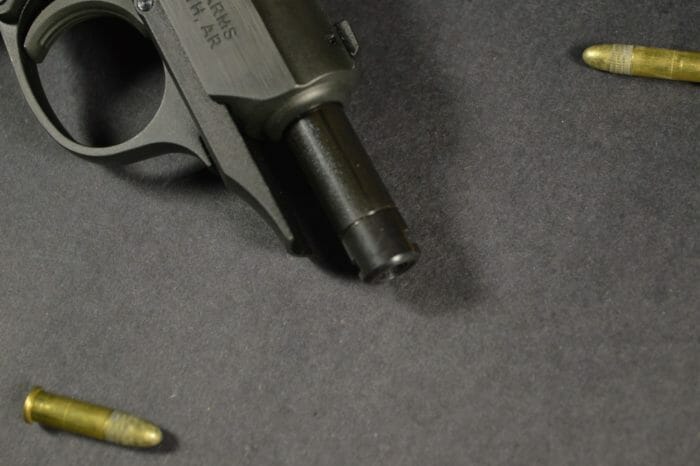
Another source of criticism for the new PPK/S .22 is Walther’s extensive use of zinc-based alloy (also known as zamak) in the slide and frame of the gun. Some of these concerns are well founded, but others are not. While most of Walther’s full-sized rimfire pistols feature aluminum slides, their popular, compact P22 uses a zamak slide much like the current PPK/S. Earlier versions of the P22 earned a reputation for being unreliable and prone to breakage, with cracked slides being one of the most common major failures. Because of this, zamak has a fairly dubious reputation among shooters.
Even so, I’m not sure comparisons with the P22 are entirely fair. The PPK/S offers a much thicker slide than the P22, especially around the muzzle and ejection port (weak spots in the older P22 pistols), so breakage seems unlikely. Zamak is significantly heavier than aluminum, meaning the PPK/S .22 feels much more like its centerfire siblings than many other rimfire replicas. A final point is that while the old .22 LR PPs and PPKs used steel slides and frames, Walther substantially reduced the thickness of the slide for reliable operation with common ammunition. As such, older .22 versions have visibly lightened slides forward of the serrations. The new model’s lighter zamak material allows a more traditional, centerfire-like slide profile.
Like the original PPK, the PPK/S’s slide mounted safety also functions as a decocker. A few people have stated that some examples of the pistol will fire when decocked, so as always, make sure the muzzle points in a safe direction before engaging the lever. Moreover, several folks complain about slide mounted safeties and how they can be unintentionally activated while charging the slide. In my opinion, these issues are overblown and it takes enough force to flip the PPK/S’s safety that only deliberate actions are likely to render the gun “safe”.
My PPK/S .22 wears a nice, even black oxide that adequately, but not perfectly, replicates the blued finish of classic Walthers. Another, slightly more expensive version of the pistol is available with nickel plating on the slide and frame that mimics stainless models of the PPK/S. Since I wanted the Bond look with this purchase, only black would do for me.
Range Report
For my initial range trips, I brought along a collection of different .22 LR ammunition types. Since these PPK/Ss have fairly strong reputations for overall reliability, I did not anticipate any major stoppages during my sessions and was more interested in seeing what types of ammunition would perform best out of the little pistol. In total, I fired around 350 rounds of various .22 LR through the PPK/S, but I will update this review periodically to reflect further experimentation and use.
Of the tested varieties, CCI Mini-Mags and Remington Golden Bullets (both 36 grain and 40 grain) were most reliable. I experienced no stoppages in over 100 rounds of the Remington ammunition and had only a single failure to ignite with the CCI. Federal Champion bulk ammunition was slightly less reliable with the PPK/S and I found that the pistol failed to extract around one per magazine (usually the first). Lastly, I sampled around 75 rounds of Aguila’s SuperExtra Standard Velocity to see how the handgun performed with subsonic loads. Reliability with Aguila’s offering was somewhat disappointing, but not surprising. In each magazine, I experienced one to two failures to extract, but most of the time it was the first two rounds that gave me trouble. It seems that the tension on the top few rounds in a full magazine causes occasional failures with weaker ammunition in the PPK/S .22. In some situations, it may be necessary to load the magazine below full capacity for reliability’s sake.
In single action mode, the PPK/S’s trigger is surprisingly good. The pull encroaches on being too heavy, but at 5 lbs 13 oz, it really is better than I expected. In double action, the story is exactly the opposite. I won’t go so far to say it is the worst trigger I have ever used (that honor goes to the M1895 Nagant revolver), but it is heavy enough to exceed my Lyman gauge’s 13 lb maximum. Walther’s documentation puts the double action pull at 17.5 lbs, which is at least 4 lbs heavier than the centerfire version, and I think they’re probably right on the money with that claim.
Accuracy with a pistol this size is always difficult to judge. The very short sight radius magnifies any mistakes that shooters make and the sights themselves are far from precise. Still, my groups were reasonably good with the PPK/S. At ten yards and with the pistol rested on a sandbag, I managed a ten round group with an extreme spread of approximately 3.5” using Aguila standard velocity ammunition. These results are not great, but I am also a mediocre pistol shooter. It is worth noting that seven of the rounds fell inside of two inches from one another, so I believe the PPK/S is mechanically capable of better accuracy than I can achieve.
Observant readers and those familiar with the PP series will notice that the PPK/S lacks a slide release/lock lever. For these pistols, Walther designed the slide lock as a totally internal affair. If you are like me and use the lever to return most handguns to battery after reloading, having to move to the “slingshot” method takes some practice. However, there are advantages to the internal lever. Most notably, it is impossible to accidentally depress it while firing. As a result, the slide can be expected to lock back reliably each time the magazine empties.
Something I noticed while shooting the PPK/S was how much more fun it was to shoot than my old 1911 Gold Cup. The lightweight, aluminum slide of the Gold Cup made the gun feel far too light for a 1911 and felt recoil with the pistol was negligible to the point of being boring. The PPK/S has a heavier (by propotion) zamak slide that seems to facilitate a shooting experience that is ever so slightly more similar to using the centerfire PPK.
Conclusion
Despite widespread opinions to the contrary, Walther’s new take on the PPK/S in .22 LR is a respectable handgun and a fitting continuation of the PP family. The rimfire’s internal design is remarkably similar to the original PP series guns and its straight blowback operating system is the same as that developed for the original PPs over 80 years ago. Sure, it would be nice to see Walther use one-piece barrels and steel slides and frames on these pistols, but for the price the chosen parts seem workable. Most importantly, the PPK/S I received is somewhat less selective with respect to ammunition brands and types as compared to my Gold Cup 1911 and Bersa Thunder 22. My issues with Federal bulk pack and Aguila standard velocity ammo seemed to improve over the course of the day and it is entirely possible that after a few hundred more rounds, these reliability concerns will disappear.
If you’re a fan of James Bond or are simply looking for a compact .22 LR handgun with a little style, the new PPK/S .22 is a solid option. Typically, the black versions of this pistol sell for around $350 while the nickel examples fetch closer to $400. Compared to much pricier original .22 PPKs, this new model is a relative bargain.
An information security professional by day and gun blogger by night, Nathan started his firearms journey at 16 years old as a collector of C&R rifles. These days, you’re likely to find him shooting something a bit more modern – and usually equipped with a suppressor – but his passion for firearms with military heritage has never waned. Over the last five years, Nathan has written about a variety of firearms topics, including Second Amendment politics and gun and gear reviews. When he isn’t shooting or writing, Nathan nerds out over computers, 3D printing, and Star Wars.


